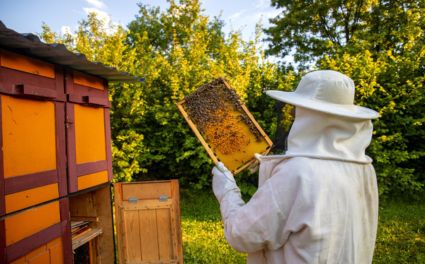Where you put the hive can make or break the whole beekeeping gig.
So, does hive location matter, or is that just a myth?
It matters. A lot.
Think about it, your bees are tiny, hardworking creatures flying miles a day to collect nectar, raise young, and guard their queen. The least we can do is give them a good start. And it starts with choosing the right piece of real estate.
You don’t need a hundred acres or a secret meadow. Whether you’ve got a backyard in the suburbs or a quiet patch of land on the edge of town, what matters most is knowing how bees see the world and working with nature instead of against it.
Let’s walk through what really counts when placing your hive, without the fluff or sugarcoating. Just the kind of real-talk advice you’d get at your local bee club or from a neighbor who’s been doing this for years.
Ever Thought Like A Bee? Here’s What They’re Hoping For
Let The Sunshine In, But Not Too Much
Bees love a warm, sunny start to the day. Set your hive so the entrance faces east or southeast so that the morning sun hits just right and gets them foraging early.
Now, if you live in a place that cooks in summer, full sun all day long can turn your hive into a sauna. Give ‘em a break. A little afternoon shade from a nearby tree or fence goes a long way.
Wind In Their Wings? Not So Fast
A breeze is fine. A constant draft? Not so much.
Wind sucks heat from the hive and wears the bees out. If your area gets regular gusts, tuck the hive behind a shed, row of bushes, or even a handmade windbreak. South-facing slopes are your best friends in chillier climates.
Water: Not Just For The Garden
Bees drink a surprising amount of water, especially when brood rearing is in full swing. But placing a hive right next to a creek, pond, or puddle magnet can backfire. Damp hives, predators, and even rising water are real risks.
Instead, give them a shallow source nearby. A dish with marbles, an old birdbath, anything they can perch on without drowning.
Field Gear Tip: After a big rain, use the OZ Armour Hive Tool Pro to lift or adjust any damp hive stands and keep things nice and dry underneath.
Where Should The Hive Entrance Face?
Picture this: Your bees fly out of the hive and bam! they run into a wall, your dog, or a playground. Not great.
Aim the entrance away from foot traffic. Face it toward open space, ideally east or southeast, and give them a clear flight path. Your bees will stay happier. So will your neighbors.
And hey, if you’re dealing with limited space, you can nudge their flight path upward with a tall fence or trellis. They’ll get the hint.
Backyard Or Backwoods? Both Work. Just Play It Smart
Got a suburban setup? You’re not out of luck. Many backyard beekeepers keep thriving hives on rooftops, balconies, and small gardens. Just make sure your bees aren’t zooming through your neighbor’s BBQ.
On rural land? You’ve got more space, sure, but watch for bears, skunks, and stray livestock. Install proper fencing and a raised stand, and you’re golden.
Suit Up Reminder: Whether you’re in the city or out in the sticks, your OZ Armour Full Beekeeping Suit is non-negotiable. Trust me, even the gentlest hive can get cranky if you show up unannounced.
Shade Or Sun? Let's End The Debate
Here's the deal: Full shade breeds moisture, mold, and sleepy bees. Full sun turns the hive into a pressure cooker. Your best bet? A blend.
Morning sun and afternoon shade are the dream combo. Think of a spot that catches rays early on but gets a little cover as the day heats up.
Hive Health Hack: With an OZ Armour Queen Excluder, you keep the brood pattern under control, especially helpful when temperature plays a role in where the queen lays.
How Close Can A Hive Be To People?
Short answer: Not too close. Long answer: Give it at least 10–15 feet from where you, your pets, or your kids hang out regularly.
Even if they’re gentle, bees don’t want to be disturbed every five minutes. And you don’t want to walk into their flight path with a cup of coffee.
Tight space? Raise the hive or install a visual barrier so they fly up and over. Everybody wins.
Got Crops Or Fruit Trees? You’re In Luck
Bees thrive near diverse, pesticide-free forage. Clover fields, backyard veggies, orchards—they’re all prime real estate for a hive.
Just one heads-up: Keep tabs on what your neighbors spray and when. Pesticide drift is real, and it can take out a whole colony in a day.
Don’t Skip These: Drainage And Access
Even if you get everything else right, a low, soggy spot will ruin the party. Always place hives on dry, level ground. And think about your future self—how easy is it to carry supers, smokers, and tools to that spot?
Avoid the "jungle corner of the yard" setup. You’ll thank yourself when it’s time to do a late-season harvest.
Must-Have: Keep your OZ Armour Stainless Steel Beekeeping Smoker on hand. Calm bees mean smoother inspections, especially in awkward or tight setups.
Before You Walk Off With The Hive Tool!
There’s no cookie-cutter answer to hive placement, but there is a best answer for your specific yard, weather, and goals. Trust your gut, watch your bees, and don’t be afraid to tweak things over time.
You’re not just setting down a box of insects. You’re making a space for a colony to grow, work, and survive the seasons with you.
And when in doubt, ask another beekeeper. Or better yet, ask the bees. They usually know what they’re doing.

Set to go from “Where do I put this thing?” to a confident beekeeper?
Grab your gear from OZ Armour:
➡️ Read More Blogs About Beekeeping to level up your hive game.


